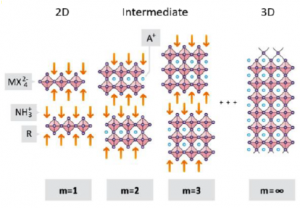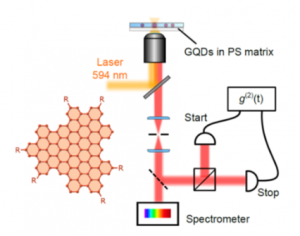Nanophotonics, Spectroscopy et Materials
The theme Nanophotonics, Spectroscopy et Materials gathers 5 different research topics:
- Molecular and Material engineering for nonlinear optics;
- Fluorescence Lifetime Imaging Microscopy;
- Optical properties of hybrid perovksites; [dedicated page]
- Optical properties of sp2 carbon materials; [dedicated page]
- Optical levitation of nanoparticles in vacuum. [dedicated page]
Molecular and Material engineering for nonlinear optics
PI: Pr I. Ledoux-Rak
This research topics aims at the characterization and optimization of the nonlinear optical (NLO) properties of molecules and materials, according to a multiscale approach ranging from the molecular to the macroscopic levels. A special attention is paid at nanoscale objects and their incorporation in various matrices to result in the elaboration of new hybrid and nanohybrid, multifunctional materials. The group has developed two exploration tools to evaluate the quadratic NLO response of molecules and nanoparticles in solution: Electric-Field Induced Second Harmonic Generation (EFISH) and Harmonic Light Scattering (HLS) with variable incident polarization, both operating at 1.06 and 1.9 μm, this latter wavelength, highly suitable for molecules and materials absorbing in the visible range, being used only by the group in a HLS.
Fluorescence Lifetime Imaging Microscopy
PI: Pr R. Pansu
The luminescence phenomenon is perfectly mastered in solution but the luminescence of the solid phase remains a frontier of knowledge with many obscure points and new families of luminescent materials that are discovered every ten years (QD, perovskites...). In order to study this luminescence of the solid state, we have developed a complete fluorescence imaging instrumentation (lifetime, polarization, emission spectrum, efficiency): FLIM (Fluorescence Lifetime Imaging Microscopy). This experimental setup is a part of the Institut D’Alembert's platforms. In collaboration with Photonscore GmbH, we chose a unique technology in France that combines sensitivity, speed and resolution. This is, to our knowledge, the fastest video-FLIM device available. In addition, we have developed a microfluidic device that provides a rich image where each position corresponds to a reaction time. The microfluidic device makes it possible to obtain different modes of crystallization: liquid / liquid phase separation (two steps model) or crystal nucleation (Classical Gibbs model). By focusing a laser in the device, we induce and observe the early steps of the nucleation.
Optical properties of hybrid perovksites
PIs: Pr E. Deleporte, Pr C. Mayer and Dr G. Allard-Trippé.
Recently the Hybrid Organic Perovskites HOP of chemical formula CH3NH3PbX3 (called 3D HOPs) represent a “material breakthrough”, particularly for photovoltaics: in several years, the efficiency of HOP based solar cells has progressed from 12% to 25,2% in 2019). This material is also suitable for light emitting devices: perovskite-based LEDs are developed, lasing is demonstrated at room temperature, opening the way to HOP-based lasers, potentially electrically injected due to the good transport properties of HOPs. Moreover, other kinds of HOPs exist such as the two-dimensional multilayered perovskites, showing interesting excitonic properties and better chemical stability than the 3D HOPs. These HOPs are now considered as a new class of semiconductors having amazing properties but still to explore. The group has a 16-year experience on the optical properties of HOPs and of photonic crystals such as vertical microcavities containing these HOPs. The group has obtained recently the laser effects in such cavities. The materials and the cavities are studied by means of micro-photoluminescence (PL), time-resolved PL, PL excitation, femtosecond pump-probe spectroscopy, as function of temperature. More details here.
Optical properties of sp2 carbon materials;
PIs: Pr JS Lauret and Dr L. Rondin
It is now well established that graphene shows unique physical properties such as extremely high charge-carrier mobility. However, graphene does not have a bandgap. Therefore, a graphene layer on its own is not appropriate for applications as active semiconductor in digital electronics or as a light-emitter/-detector in optoelectronic devices. To this end, the main challenge for scientists is the control and modification of the electronic and optical properties of graphene, as the opening of a sizable bandgap. One way consists in using size reduction effects. The reduction of one dimension of graphene leads to carbon nanotubes and graphene nanoribbons while the reduction of the two dimensions leads to graphene quantum dots. In the group, we are studying all of these nano-objects. The research on the optical properties of carbon nanotubes is ~18 years old. Therefore, a lot of the basic properties of nanotubes have already been investigated, and the group had significant inputs in this field. Nevertheless, there is still some work to improve our knowledge on this fascinating object, as for instance the understanding of their low fluorescence quantum yield. On the contrary, nanoribbons and quantum dots synthesized by bottom-up chemistry are quite new objects that are full of promises both from a fundamental point of view and for applications. More details here.
Optical levitation of nanoparticles in vacuum
PI: L. Rondin
Optically levitated nanoparticles in vacuum offer unprecedented control over its environment. Thus, it provides a perfect platform for the study of nano-stochastics thermodynamics and quantum phenomena on a mesoscopic object. Until now, the center of mass motion of the levitated particle has been at the center of most experimental realizations. However, the full control of the particle requires to also address other degrees of freedom, such as rotation and vibrations. In that context, we propose to couple the levitated particle to an ancillary system. NV color center, a point defect of diamond, due to its unique optical and spin properties, is a candidate of choice. Notably, it has been proved an excellent tool for quantum sensing of magnetic fields, temperature, and potentially rotations. More details here.


















